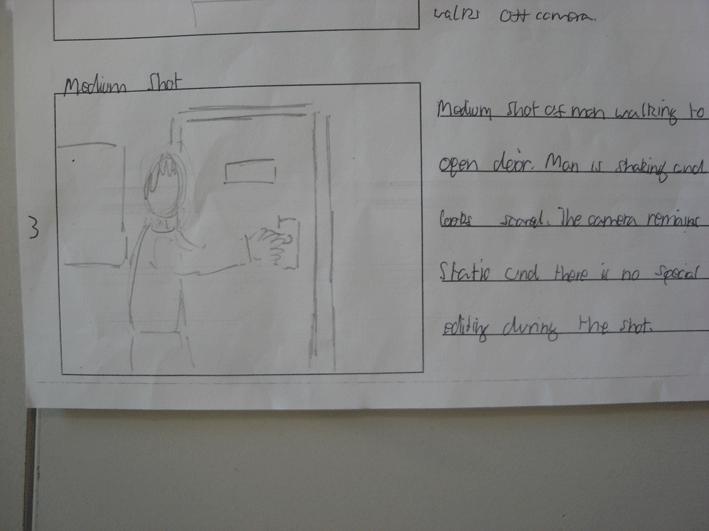Health and Safety considerations:
When using either the red heads or the portable lights we must make sure that any waires are taped up and that the lights themselves are on a stable base as so thay do not fall and cause injury. GLoves will be used when handling these lights, especially when they are turned on to avoid buring
Props:
As we are planning to use knives in our film we must make sure that we handle them with care, especially around other people
Trains:
We are going to be filming at a train station so we must take obvious precautions to not endanger ourselves or other people that may be at the station
Synopsis of Thriller opening - David, Chris and Jamie
The plot of our thriller will be based on a phycotic murderer who is pursuing a victim. We will base this in a village and the targeted victim will be at a train station when the attackes choses to strike. The victim is then taken back to a house where he is gagged and knocked out by the murderer, with the use of knives the killer will kill people from his list of targets. The list is kept in the form of pictures.
The film starts whilst the victim is on the floor of his house, there will then be a flashback and the story will follow from there.
Friday, 30 April 2010
Chris Forrest 'The List' Thriller Opening Evaluation
Enigma is probably the most common and effective technique used in any thriller product. Enigma is the word given to anything that raises questions amongst the audience about the narrative, an example of this would be if we are shown a character, but are not told or shown anything about them; Enigma would be raised as we begin to question their identity. Another example of enigma, in the film ‘Seven’ during the title sequence, we see a character writing and cutting the skin off of his finger tips, we never see his face, which makes us question his identity and whether he is a Protagonist or Antagonist. In our final product we have created enigma in various ways –
· Haven’t shown any faces, raising questions about his identity.
· Clashing soundtrack, raising questions about the genre and mood.
· No establishing shots are used, so questions are raised about where the characters are in relation to each other.
· Opening shot of a man on the ground raises questions like – who is he? Is he alright? What’s happened to him? Etc...
Another technique used in thriller products is Restricted and Unrestricted narrative. Restricted narrative is an effective way of creating enigma, as we are limited as to what we see in the frame, we don’t have a full understanding of what is going on. This creates tension and suspense as the audience doesn’t know what’s going to happen next. For example in the short film ‘Joyride’ – a character was locked in the boot and the camera stayed in the boot with him, the narrative outside was restricted, so the viewer wouldn’t know what’s going on outside creating tension and an urge to keep watching. We have incorporated restricted narrative into our final product when the Antagonist is on screen, we used close ups so the audience doesn’t know where he is or what his surroundings are like. Another use of restricted narrative is where we have kept the antagonists identity relatively hidden by not showing their face.
In our product, we have covered various aspects of mise en scene.
· Costume - The antagonist is wearing black which typically represents evil; this was our way of expressing that he is a bad person without giving too much away.
· Setting – Typical house showing that the protagonist is just an average person during his daily routine
· Props – The knife in the foreground of the medium long shot where the protagonist is buttering some bread is used to reflect the antagonist, as the knife is the only object that is in focus in the frame showing that the killer is in killer even though he isn’t in the house with the protagonist.
· Lighting and colour – in our group, I raised the idea that we should use low key lighting when the Antagonist is on screen so that the flicking between the two characters was clear, my fellow group members didn’t agree with this so we kept the lighting the same throughout, not showing a clear separation between the two characters, which may raise enigma in the audience, as this way it is unclear who is the protagonist and who is the antagonist in the frame.
We used various camera techniques and angles in our product. We used a high angle showing the protagonist leaving the house, the camera was placed so that you could see the character through the banisters, giving the idea that he is being watched by someone. We also change the depth of field in this shot, as we go from focusing in on the banisters to focusing in on the character, showing that someone is focusing on him and is watching him for some reason, which again creates enigma.
We did discuss the three stages of narrative as a group, but we came to the conclusion that if we involved all 3 stages, this thriller opening would appear as more of a short film, so we based the opening around ‘the set up’, showing both the antagonist and protagonist going about their routine before the inevitable ‘confrontation’ that would take place later on in the film.
It is clear that the protagonist in the picture is a student of some sort suggesting he is in his late teens, we understand this because he is shown picking up his rucksack, which is a typical prop used to express a younger age. The use of a younger character can suggest vulnerability due to immaturity, size and experience. In most films where people are victimised, the victims are usually teenagers, for example in films like ‘Nightmare on Elm Street’, ‘Friday the 13th’ and ‘The Texas Chainsaw Massacre’. Teenagers are used as the victims because the films are aimed at a teenage audience, if the victims in the picture are of the same social group as the viewers, more tension will be raised as the audience will begin to think whether such a thing could happen to them in real life. It was hard to show a specific social group in our product as we didn’t really show much of the characters, the whole sequence was based around extreme close ups of objects such as light switches, a kettle, a knife, and a cup being filled with water, through the use of this, the narrative was restricted leaving any form of social group relatively hidden.
As a group, we discussed and researched which company/institution we would approach to distribute our film; we discovered that Alfred Hitchcock’s film ‘Vertigo’ was distributed by Paramount Pictures, due to the success and popularity of that film we decided that this would be the institution for us. Paramount Pictures is well known for distributing huge blockbuster films all over the globe, for example ‘Shrek’. We could also look into internet broadcasting and have the film streamed over the internet, meaning it is easily accessible for the viewer, which may draw more interest. Another way of making the film easily accessible at home is getting in contact with companies such as Sky and Virgin, and give them the rights to have the film played over their channels on the television so the viewer wouldn’t have to leave their home to watch it.
The target audience would be teenagers, as the victim in our film is a teenager. The audience would be able to relate to the victim as they are the same age, which would create more tension. An example of another thriller film that this target audience would enjoy is ‘Donkey Punch’ due to the late teens/early twenties cast making it easy to create a bond between the viewer and character.
I have learnt a lot constructing this product. I learnt how the basics to using a camera, for example even something as simple as setting the white balance, before we started this project I had no idea how important this was. I also learnt how to change the depth of field whilst filming which proved helpful as it added a nice effect to one of the shots in our final product. I learnt how to use iMovie and Final Cut. I learnt how to incorporate titles into a moving frame, and I learnt how to use fade in and fade outs effectively, compared to our work on our preliminary, our work on the hardware side of things was much more advanced.
If we compare our final product to our preliminary task, I believe we have advanced immensely, we have used much more camera techniques, such as use of depth of field and hard focus, and we were also tighter with the white balance issue, so that all the shots were the same colour tone. I believe editing ran a lot smoother this time as we managed our time appropriately to the task in hand. I believe the narrative in our new thriller was much better than the preliminary, as our first effort didn’t really create suspense in the way we wanted it to. When all of this is taken into account, I believe we have created an effective opening sequence that raises enigma appropriately and keeps the audience intrigued as to what happens later on in the film.
Thursday, 29 April 2010
Se7en title sequence analysis - David Duffy
- The various things that the antagonist does on screen are disturbing eg cutting his skin off, and this will raise the question to the audience as to why he is doing this
- The non-diegetic sound of the music has a very uneven and uncertain tone. This keeps the audience on edge as they will not know what is coming next
- The text used o the titles are interchanging and are constantly moving to represent the uncertainty of the situation and the killer. The colour of the text is grey, connoting misery and death
- The text is related to the narrative of the film but does not interfere with the actual actions on screen
- We are given a frustratingly short time to view the antagonist’s setting, the codes that could hold many answers to the later part of the narrative, this frustrates the audience and is use of closed narration
- The setting seems, dark, dank and the colours of the props around the character are all of blacks, greys ect, all of these could be seen as connoting death
Blog Problems - David Duffy
Tuesday, 20 April 2010
David Duffy Evaluation
The idea behind the light switch shot is that the character is metaphorically ‘turning on’ the story.
We tried to create lots of enigma in a variety of ways, one of which was through using restricted narration to frustrate the viewer. We used this throughout the film such as when both characters are preparing for different things, you hardly see the protagonist’s (left) face and you never see the antagonist’s (right) face.
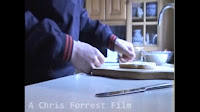.bmp)
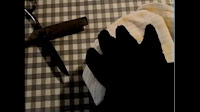.bmp)
We also restrict the audiences view of things by having certain shots with different depth of field, we used shallow depth of field in a few of our shots, but we used full focus shots for the most part of our film. We also used depth of field to draw the viewer’s attention from one part of the frame to the other. This was especially useful when we were making our titles.
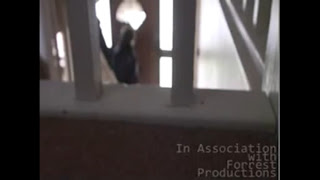.bmp)
Character
As we only had two minutes, it was important for us to try and establish the key characters and their traits straight away. The protagonist after first being shown on the floor has a flashback to earlier that day. We show some of his morning ritual to show to the audience that he is intended to be a ‘normal’ guy. Through the use of gentle, everyday, props such as butter ect and through the use of setting. The setting is my house and does not bear any disturbing qualities.
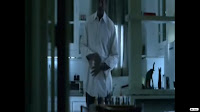.bmp) http://www.youtube.com/watch?v=Z-u3fQOOZ34
http://www.youtube.com/watch?v=Z-u3fQOOZ34The setting and props used for the antagonist on the other hand are supposed to unnerve the viewer as he is living in a ‘grimy’ location. There is an obvious use of iconography within the scene at the antagonist’s home; the large kitchen knife stained with blood is meant to present this character as dangerous. One may notice that this particular medium close up shot is almost opposite to another shot earlier in the sequence.
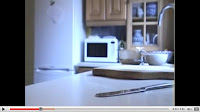.bmp)
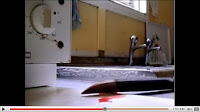.bmp)
The butter knife belonging to the protagonist on the left is supposed to suggest that he is calm and harmless, where as the large, sharp kitchen blade on the right is supposed to make it obvious to the viewer that he is dangerous and disturbed. The blood also helps to create this sense.
Even the colours of their clothes can help to put a picture of the character’s personality together, the antagonist wears dark black clothes eg gloves for the most part of the sequence. The protagonist wears normal, not to bright, but clothing that wouldn’t suggest anything sinister about this person
Lighting
It was difficult for us to use lighting to our advantage, we found that once college had finished we were rushed to get filing done before it went dark, however this wasn’t a problem when we filmed at weekends.
We used mostly high key lighting, especially for the shots within the protagonist’s house to signify his sense of transparency and innocence. Although low key lighting was used in one medium shot in which the character switches off the light and walks out the kitchen door.
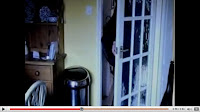.bmp)
Lighting is probably something that we should have made more use of, if we had made more use of the red head lights we may have had more option of shooting slightly later in the evening, it also would have added more quality to our product.
Camera Movement and shots
This helped us to create more closed narration as we are restricting the audience’s view, and to in turn also create enigma. It was also useful for making our titles as we found that we could blend the titles into the narrative (although without disturbing the plot). We actually made it so the titles moved with the characters at certian points.
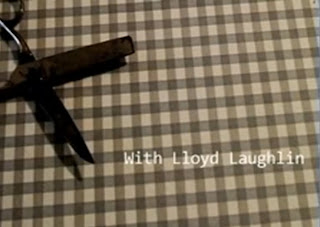.bmp)
One of my favourite shots within our film was the use of a canted camera mid-way through the film, it gave us space for some titles and it worked well in our sequence. A canted camera angle was subtle.
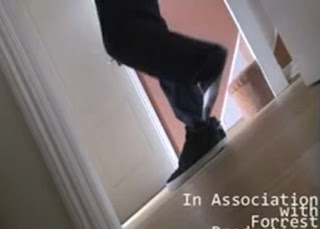.bmp)
For most of our shots the camera was static, but for some of the extreme close ups we used freehand camera. This made a slightly jolty movement which we think creates a sense of urgency about this man’s movements.
At the beginning of the sequence we had a montage of close ups one after the other. This quickly builds up some tension and also creates a sense of urgency within the film. This was inspired from the film 'Shaun of the dead', even though this is not a thriller and is indeed a horror/comedy it was still useful for this short part of our film.
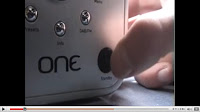.bmp)
.bmp)
This idea was inspired by the montage of close ups during the title sequence of the film se7en. The use of extreme close ups shows the disturbing nature of the character, it also creates closed narration through restricting the audiences view of the killer and therefore creating enigma.
You can see the full title sequence for se7en at youtube: http://www.youtube.com/watch?v=yALjuJcfg90
The final shot in our sequence is after the main title appears. After the wors 'The List' fade away a fast moving train appears at the end, this was intended to shock the audience and to simply keep them on edge.
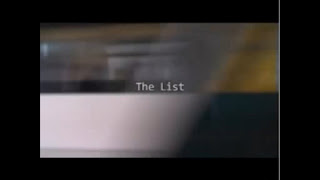.bmp)
Sound
We wanted to make use of an ambiant soundtrack or some music that would run throughout the most part of our film. We eventually decided that using this light-hearted jazzy type music would be appropriate. We thought that having the tones from the music contradict the ones from the images would provoke curiosity from the audience. The music seems to fit at the beginning of the extract as the protagonist isn’t doing anything sinister or out of the ordinary, it makes it seem as if the protagonist is oblivious to any possible danger.
We also faded out the music once the setting had changed so that it was only very faint in the background, we used this to help establish a different place in the film.
How does your media product represent particular social groups?
In truth it is hard to establish any kind of social group at first glance at our product as we see so little of the character’s faces. The main focus is on the actions in the thriller opening.
But that does not say, however that this film would not have gone onto to represent particular social groups, in particular a slightly younger group of people, (possibly aged around early twenties, late teens) this group is represented through the items of the protagonist. He holds a rucksack; this is an obvious symbol of a student or a young person off to work.
.bmp)
We used this social group because we knew that it would relate better to our class audience. It is also highlighting the possible vulnerability that people sometimes associate with young people wondering on their own. So this film is not just aimed at young people but also an older audience as well as this will relate to parents who have children who live alone. Obviously we are not suggesting that parents should not let their children leave the house but it would hopefully unsettle any adults watching the entire film to create the tension required to make it a climactic thriller.
Programs like ‘Skins’ have been building up stereotypes and different characters of young people in the UK, we would hopefully play off this generation for our film. If we were to complete the whole film, the representation of woman would be modern. This is because that the traditional representation is now inaccurate and doesn’t really apply to society today. Also modern woman in TV or films are more complex characters to show and are therefore more interesting. A modern woman may be seen as strong, independent and self-reliant. Whereas the traditional representation would be the exact opposite of all of those features. Although it is hard to back this speculation with evidence because we have only featured two characters in the opening to our thriller.
Although with the music we have used, it is hard to relate this to a young adult audience. The slightly jazzy piano music would perhaps attract a more matured veiwer, but this film is full of contrasts. The music may even link directly to either of the two characters; it could reflect the protagonist’s personality of being calm, couls suggest to the veiwer that he is too careless.
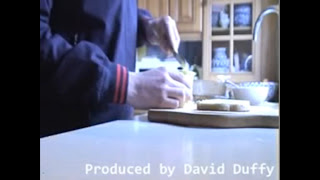.bmp)
The protagonist’s clothes are not supposed to provoke anything in particular as he is wearing normal clothing (see above), this would hopefully make the audience accept him as a normal person. This makes the situation all the more sinister as one would have to ask what does this man have to do with a dangerous and psychotic person in the other setting of the thriller. But despite attempting to present this man as young, we also wanted to create some form of suspicion as we used so many extreme close up shots to try and make the audience feel untrustworthy of this person.
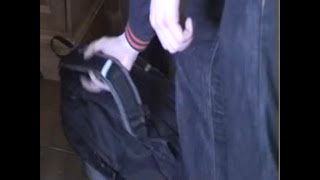.bmp)
At the same time the protagonist character would challenge the normal common ideas of the young British male stereotype. Also, we planned to use women characters in a way that would not show them as victims, but counterparts to the main protagonist. It has become common for female characters to play just victims where their binary opposite is masculine.
So overall we are trying not to conform to the common thriller conventions. We see this usage of the stereotypical women victim character in many of Hitchcock’s works such as Vertigo where Kim Novak’s character is vulnerable and requires the male character played by James Stewart to protect her. Hitchcock constantly used women, particularly blonde, to play similar roles. But this is not to say however that his characters were so traditionally based.
For the antagonist, it is hard to relate this man to a particular social group; the film focuses more on the social groups that he targets for victims.
What kind of Media Institution might distribute your Media product and why?
We would hope that our film would fit into the category of a blockbuster film. By this we mean that we want to distribute the film via the usage of major companies for instance New Line Cinema.
The company that we would most like to go through would be Paramount Pictures. We would chose this company because they have an excellent history of producing many excellent films and in particular thriller ones. Perhaps the most famous director of all time, Alfred Hitchcock, had his film ‘Vertigo’ was first distributed through Paramount. They are one of the world’s leading distributers in film and their recent profits have been on the rise. They also have a great online film community which could be used to tell people of our film through the use of forums ect.
We would of course give Paramount licensing rights in order to help distribute the film as much people as possible. But there are certain measure that we could take ourselves for instance we could use Facebook, Twitter and Myspace fairly cheaply
Another film which Paramount distribute is ‘Shutter Island’ which is a recent thriller starring Leonardo de Caprio, the themes and tones created in this film reflect the aims of ours.
But most importantly is that they have links and influence across the entire film industry, having business links with the likes of DreamWorks ect, so they would be able to get our film the most publicity and also get it across the entire industry.
We would want to take full advantage of the newest innovations in distribution, such as the usage of digital distribution; Paramount even has their own Digital Distribution section of their website.
However we may also look to do a deal with a major video games distributer such as Microsoft and Sony. We would not preferably to a deal with Nintendo because they have a too younger audience. We would hopefully be able to post small clips and trailers of our film onto the main pages of people’s games consoles. I know this to be effective as we can see this with the ‘Lynx Twist’ short films on the Xbox 360.
Obviously we would want to put our prints into as many big cinemas across the UK, so that this would be a high concept film, if we were to get the help of Paramount Pictures then we could easily.
We hopefully use the obvious routes of advertising to remind every person of our film. These would include TV trailers, Internet ads (on the side of certain websites), also posters and billboards in dense cities where there is a big film community. And also we would hope to exploit the ‘Videos on Demand’, such as Sky movies once the film is out. But of course these costs would have to be met by Paramount Pictures.
Who would be the audience for your media product?
There would be no particular gender target audience for our film, despite the main characters being men. Our film would also be rated a 15 as it will contain content that is intended to disturb the veiwer but there isn’t a big use of graphical content and gore. We aim to be more subtle about our film.
Even though the age certificate would be 15, the target audience would be anything from 15 + as when it comes to thrillers; they have a much broader market appeal then say a period drama like Pride and Prejudice. However we would expect that a slightly younger audience may be more drawn to it because of the young age of the characters on screen.
I personally asked many people who watched our film, and enjoyed it, as to what was their favourite thriller at the moment. 70% of those people said ‘Shutter Island’.
When i asked the same people when given a choice of: Vertigo, Memento, Se7en or The Birds – 60% of them said that they preferred either Se7en or Memento.
These people are students from my college and it is clear that they prefer the more modern films such as ‘Memento’ rather than the old classics such as ‘Vertigo’. This is good because these are the kind of films that we are trying to emulate.
What have you learnt about technologies from the process of constructing this product?
List:
Camera tripod
Red-Head Light
Light tripod
Also Mac computers with:
Final cut pro
Imovie HD
Garage Band
We learnt vast amounts as a group about the various equipment that we used. We were very lucky to be able to use the HD cameras available; this allowed us to tamper with the depth of field far easier because of the option of a manual zoom. The quality of the camera was also outstanding, especially when compared with the smaller cameras. Also the sound that was picked up was of much higher quality because of the very sensitive mike on the camera.
We made the first usage of the red head lights for filming our sequence and it certainly helped to duplicate the light of day during the evening. This was especially useful as we filmed in the winter, where it got dark very quickly after college so we had limited time to film; the light meant that we could film for longer without the darkness having an effect.
In terms of safety, we had to be far more aware of the potential hazards as we had more equipment (and more expensive equipment for that matter) to use. We put sandbags over the tripod of the light so it would not tip, covered wires in duck tape and used gloves for when handling the light as it got hot after sustained usage.
Also, we have learnt about blogging through this media task. None of us within the group had ever used or made a blog before and it was an enjoyable new way to do coursework. It meant that we could get more creative. Although overall I do not believe that the blog has made this work any easier, in fact it has made it more complicated and strenuous. This is because the writing tool for the blog is useless as it is very annoying just to move a picture around. Not only that but the whole structure and spacing of an essay can randomly fall apart once you log off.
We all learnt bags of stuff about the usage of new software, especially Final Cut Pro and Garage Band. We used this for the most part of our editing and it was especially useful for creating our titles throughout the film. Final cut is more complicated and detailed then imovie, so this allowed us to use more complex methods to create an overall better film.
I believe that to make a modern successful thriller it has to be pact with enigma provoking shots. We see this in such films as Se7en, especially in the title sequence.
The veiwer has to ask questions at the very beginning of the film as to why there is a random man on the floor. We think that by using many extreme close ups we have limited the view of the audience and have created closed rather that open narration. We can see this in our thriller by watching the montage of close ups whilst the protagonist is in the kitchen, preparing for his day.
We tried not to use violence in the opening sequence because otherwise the veiwer would have thought that this violence would re-occur throughout the whole film. Btu we did, however, try to connote the previous and future usages of violence through the use of iconography. By placing knives in the camera shot stained with blood, the connotations to the veiwer are obvious. By not actually showing the knife being used, it will almost tease the veiwer.
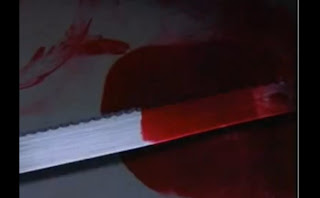.bmp)
In terms of story there is little to give away from the opening 2 minutes. However, the very first shot is very provocative as there is a random man on the ground. By using a flashback here we frustrate the veiwer by going back in time and not explaining why he is there straight away. I think that twists like these will attract a younger audience, interested in seeing something different.
We also attracted people by using depth of field. This proved to be a great way of creating closed narration by blurring and therefore restricting the audience’s view through. We continually used shallow depth of field.
.bmp)
The music for our film is curious for the audience, after seeing the disturbing opening scene and then the flashback, the audience will be worried when they see that the protagonist is playing jazzy, causal music and this suggests that he is unaware of his impending danger.
Assessing our effort and work
I believe that I put enough effort into our film to be recognised as a major contributor. I turned up to every filming and editing session and was also a contributor into the storyboard and the original ideas behind the film. However I could defiantly have been more organised throughout the process, despite always turning up I could of perhaps made more effort to organise filming and editing sessions. I also made mistakes when filming eg, forgetting the tape (although we borrowed some else’s) and actually forgetting to pick up the camera at the end of the day. However I am not a total idiot and these mistakes were not made more than once.
The main fault behind my organisational skills was that I didn’t recognise early enough when something went wrong with our blog. For example we were given the tasks of analysing 5 title sequences from other random thrillers, I completed the task but for some reason the blog failed to publish the posts. I only realised this until a day before the final deadline for the whole blog so it was frustrating knowing that this problem could have been avoided had I done a more thorough check on the blog posts earlier.
Jamie gave great input the whole way through the process, whether it be editing or filming. He was also especially good for the storyboard designing process. It was always going to be difficult to meet up outside of college because he lives in a different village, as does Chris. But this was rarely an evident problem as a know Jamie very well and can easily contact him at any time.
The same can be said for Chris as he too lives in a different village but still made the effort to meet up and stay in contact. Chris also made very creative inputs for the narrative of the film which helped to improve the quality. He also helped us to drop certain parts of the film that weren’t needed which helped us keep to our 2 minute time limit. At certain points during the whole process, Chris sometimes missed sessions due to illness, but he did make up for the absences by keeping track of what me and Jamie had done. These absences were also rare.
Peer Evaluations:
Good:
- Looks like a thriller
- Lighting is very good, separated each character well
- Confuses veiwer (in a good way)
- Knife in the sink especially effective shot
- Good use of iconography
- Music contrasts well with the images on screen
- Good titles and effects
- Good use of depth of field
- Enigma as to who the characters are
- identities not revealed – good enigma
- Good Mise en Scene for second character
- Music volume changes to show different settings
Bad:
- Music did not work well
- Shot of protagonist leaving, lighting was too bright
- Music made it seem like a Rom Com
- could be more effective with non-diegetic sound
What do you feel you have learned in the progression from the preliminary to the final product?
I think that we have made substantial progress in terms of quality from our old preliminary task to this one. I think that one of the main factors in this has been that we have been using better equipment and technology, as for the first attempt we only used Imovie. This meant that there was very basic use of continuity editing, however we did what we were asked to do in the preliminary tasks and our knowledge of final cut pro was next to nothing. Also we had a better quality camera for this thriller and we also actually made use of the red head lights.
Small details such as mistakes with the sound eg, we had some people talking in the background in one of them, made our preliminary task look shabby and rough around the edges. We have made a much better use of continuity editing in ‘The List’ as we have led the audience through far smoother than before. With the use of transitions such as fades the film seems to just to flow much better. However if it had not been for our preliminary task we probably would not have used such things like a parallel editing which we made a lot of use of in ‘The List’.
I think that we have also exploited the possibility of using depth of field in this thriller. And our overall use of shots to match the characters and to close off narration has been better. As it is an opening sequence we tried to use shots that would simply draw people, so we used very little medium shots so as to not seem mundane and we used many extreme close ups to restrict the veiwer and just to give a more dynamic approach the film.
We have also been more subtle about how we try to create character through props and mise enscene. For starts we avoided using hooded tops as that is a cliche and a cheap way to try and create a sinister antagonist. We kept facial shots on our opening to a minimum and included no dialogue, this isn't anything new as we never wanted to expose our poor acting capabilities.
Monday, 19 April 2010
Jamie Hunnisett - Evaluation
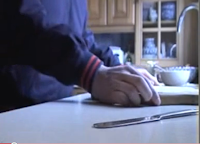
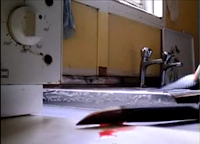
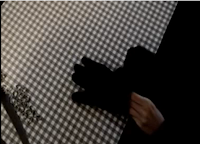
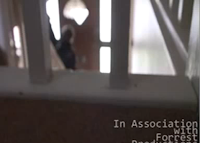
Sunday, 18 April 2010
The Good, the Bad, and the Ugly Opening Titles Analysis - Chris Forrest
red, green, black, blue, brown.
Red being the most common suggesting violence as the colour red is typically associated with blood.
The music and sound effects make it obvious that it is a western film, the soundtrack used is a very famous wild western linked tune. The gunshot we hear represents a shootout that would typically take place in a western film, the gunshot may also suggest violence and death.
Parts of the narrative are shown behind the text in this sequence giving the audience a general idea of what is going to take place and what the characters look like.
A saloon based font is used, which is another sign that tells us that this is going to be a western/cowboy film.
All of these points added together create an effective title sequence which gives the audience a basic understanding of the location, characters, and general idea of the film.
The Number 23 Opening Titles Analysis - Chris Forrest
typical jet black typewriter font is used, various typography techniques are used, for example -
- different line lengths
- random red words
- line spacing
- typeface
This suggests confusion and insanity, which raises enigma as we question the narrative.
Blood randomly splatters across the frame suggesting violence and death, adding to the narrative but still keeping it restricted which raises more enigma.
From what we can read in the text on screen, we gather that the film is obviously going to be about an obssession of the number 23, as it has many different dates of disasters, i.e titanic, and the day war was declared which all add up to 23.
No characters or locations are shown in this title sequence, yet it still manages to draw interest through text and imagery which works effectively. I would've very much liked to have incorperated something like this into our group film.
The Forgotten Opening Titles Analysis - Chris Forrest
Titles fade in and out in a white neutral font adding nothing to the narrative as there is nothing distinctive about the lettering.
Restricted narrative is used throughout this title sequence, examples of this are:
- we are not shown exactly where the shots are taking place
- no information is given away about the characters on screen
When the woman looks at the picture of the boy, we assume that it's her son, but she may also be seen as the antagonist and the boy might be the victim, the soundtrack suggests this in a way as it creates an uneasy, dark atmosphere.
By keeping such things hidden, Enigma is raised very early on keeping the viewer interested which is something we would like to incorperate into our final film.
Sunday, 4 April 2010
Film Finished
Wednesday, 31 March 2010
Changes to our locations
- The current location shots will be changed to fit the actual footage but until then the current ones are inaccurate
Title editing - David Duffy
- We chose a plain but non-boring font that isn't cliche, the text themselves do appear into our sequence but do not actually give any infomation about the narrative of the film - the white text does not provoke the viewer in any way and it is not designed to
- We have used fades to introduce each of the titles, this hopefully will mean that the text will not ;draw too much of the veiwers intentions as the titles bear no other significancxe other thatn to show who was behind the making of the film. Although having said that the title that actually presents the name of the film 'The List' is supposed to grab all of the veiwers intentions as it is in a shot of its own
- Although we were considering using the methods of Sual Bass, which would involve having a title sequence tottaly seperate from the narrative but still related, we decided that this would be very difficult given our lack of expertise of the advanced parts of final cut pro. This would have also eaten into our restricting two minute time limit
More Editing - David Duffy
- We have used final cut pro for the majority of our editing process, we originally used imovie but the effects and transitions on that program were not sufficient for our needs
- We have put together an opening which we believe makes good use of close ups to disturb the veiwer, we are also relatively pleased with our depth of field as we have used shallow depth of field where we saw fit, although we would have preferred to make more use of long to extreme long shots to introduce a bigger variety but with a two minute limit we were restricted. And bearing in mind that this is only the opening of the film and we should make it seem that way, so it is good that we didn't make the mistake of creating simply a catalogue of shots in two minutes
- We think that our opening does carry enigma and raises questions to the veiwer that would be answered in the rest of the film
Wednesday, 24 March 2010
Shaun of the Dead Inspiration - Chris Forrest
There are several sequences in Shaun of the Dead that show a number of shots being played simultaneously at a fast pace, giving a sense of rythym. It is effectively used as it shows the daily routine taking place (brushing teeth, toilet etc..) so the audience get an understanding of what the character is doing, in the space of a couple of seconds. We are aiming to incorporate something like this in our thriller opening, so the routine taking place doesn't become tedious but the narrative is still clear. The fast paced cuts between shots may also create tension and enigma as we don't see much of the character and their actions.
Title Sequence Analysis - Taxi Driver - David Duffy
- The colours of the titles are yellow - relates directly to the actual taxi, film maker has used low key lighting for much of the sequnece to help create the dark and sinister atmosphere - also the use of red lighting when we see extreme close ups on drivers face suggests that the driver is a dangerous or angry man
Monday, 22 March 2010
Todays Editing
- We think that we have done well with our use of extreme close ups and depth of feild, further filming may be required
Sunday, 21 March 2010
Train Station update
Friday, 19 March 2010
Filming troubles...
Monday, 15 March 2010
Filming update
Certain shots have worked well for us so far such as a repeated use of the extreme close up; we also think that we have used depth of field to our advantage in the sequence.
Sunday, 14 March 2010
Saul Bass
Saul Bass was an American graphic designer (May 8, 1920 – April 25, 1996) and Academy Award-winning filmmaker, the things that made him most famous, however, was his animated title sequences. He worked with such directors as Alfred Hitchcock and Stanley Kubrick. He worked on legendary thrillers such as 'Vertigo' and 'Psycho', and added to the tension created by Hitchcock.
Bass was an expert at designing things that stood out, as well as title sequences he also created logos for many huge companies, such as the Continental Airlines' 1968 "jetstream" logo which became the most recognized airline industry logo of the 1970s.
His work is very relevant to what our group is doing now as his title sequences, although very clever, are simple to do to an extent. Obviously this varies from sequence to sequence but as we can see in such films as 'The Human Factor' not all of it is impossible to duplicate and draw inspiration from.
Title Sequence Analysis - David Duffy - The Human Factor Saul Bass
- Straight away the viewer is confronted with a thick, red background. This may shock the viewer as it connotes blood and death
- There is little to no detail about the actors in the film and the director, it restricts the viewer’s early understanding of what is in the film and by doing so it creates enigma
- The view of the screen pans along the wire of the phone; this is further restricting the viewer’s understanding of the film as the viewer is frustrated by the extreme close up of the wire which shows nothing else in the sequence
- The phone hanging on an almost broken sting carries a lot of symbolism, otherwise it would be pointless. The viewer is meant to become more understanding of what that phone represents as the film progresses.
- The slow movement of the camera slowly builds up tension, the audience will then naturally expect something to end the climax, but when it doesn't really come it leaves the viewer curious and questioning the themes of the film
- The sequence certainly has a lot of enigma, ie what is the significance of the phone and how does it relate to the film, a very easy way to create enigma, can be used for our sequence or at least something similar.
- Like much of Saul Bass's work, this title sequence does not interfere with the actual film, would be easier for our group to do a Bass style title then one which interferes with the movie. If we were to chose a title sequence such as this then we would run the risk of making the film opening seem tacky and unprofessional
- The non-diegetic music is useful to us as we could record something similar to this ourselves, the sequence only has the use of a guitar, it is provocative because of the slight changes in pace and note.
- The music also relates itself to a Spanish background, as does the colour red – it is perhaps possible that these are deliberate methods of Bass to introduce the mood for the rest of the film and to drop hints about the content
- The black colour of the film gives away little to the viewer, it is more bold and is more memorable in total black. As always the colour black carries with it slight connotations of death – this use of colour is useful to our group as they are simple ideas but effective.
- The lettering is simple. Stationary and bold it makes it seem as if the text is part of the city
- The colour of the text (Grey) also reflects the urban setting on which the title sequence is based
- The titles seem immovable as if they are part of the environment
- The typography is linked to the narrative on screen but do not interfere, despite the fact that they have similar aspects to the buildings in the frame. The solidness of the typography suggests being locked into something – could relate to the ‘Panic Room’ in the film
- The slow pans around the text create tension as the viewer is slowly revealed more in the shot
- On especially effective pan is the high angle coming down at 1:27
- Useful for our title sequence as we would probably be using stationary lettering, however we would not use them in the same style as in this sequence the typography is the focus of the intro. In our opening the text would merely be on the side – as to not draw viewer away from on screen actions
- There is non-diegetic and diegetic sounds, the music carries a sinister tone – use of orchestral music. Music turns deeper when main title ‘Panic Room’ appears, also plays at a faster pace to create urgency. Diegetic sounds include certain noises from the city e.g. police sirens, gives sense of crime or urgency


.bmp)
.bmp)
.bmp)
.bmp)

.bmp)














